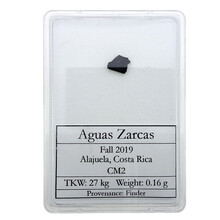The Aguas Zarcas meteorite, which fell in Costa Rica in 2019, is considered one of the most detailed representations of organic synthesis in the early solar system. The meteorite contains valuable information about prebiotic compounds. Read more.
The Aguas Zarcas meteorite, which fell in Costa Rica in 2019, is considered one of the most detailed representations of organic synthesis in the early solar system. The meteorite contains valuable information about prebiotic compounds.
The Aguas Zarcas meteorite, which fell in Costa Rica in 2019, is considered one of the most detailed representations of organic synthesis in the early solar system. The meteorite contains valuable information about prebiotic compounds.
The Aguas Zarcas meteorite, which fell in Costa Rica in 2019, is considered one of the most detailed representations of organic synthesis in the early solar system. The meteorite contains valuable information about prebiotic compounds.
The Aguas Zarcas meteorite, which fell in Costa Rica in 2019, is considered one of the most detailed representations of organic synthesis in the early solar system. The meteorite contains valuable information about prebiotic compounds.
The Aguas Zarcas meteorite, which fell in Costa Rica in 2019, is considered one of the most detailed representations of organic synthesis in the early solar system. The meteorite contains valuable information about prebiotic compounds.
The Aguas Zarcas meteorite, which fell in Costa Rica in 2019, is considered one of the most detailed representations of organic synthesis in the early solar system. The meteorite contains valuable information about prebiotic compounds.
The Aguas Zarcas meteorite, which fell in Costa Rica in 2019, is considered one of the most detailed representations of organic synthesis in the early solar system. The meteorite contains valuable information about prebiotic compounds.
The Aguas Zarcas meteorite, which fell in Costa Rica in 2019, is considered one of the most detailed representations of organic synthesis in the early solar system. The meteorite contains valuable information about prebiotic compounds.
The Aguas Zarcas meteorite, which fell in Costa Rica in 2019, is considered one of the most detailed representations of organic synthesis in the early solar system. The meteorite contains valuable information about prebiotic compounds.
The Aguas Zarcas meteorite, which fell in Costa Rica in 2019, is considered one of the most detailed representations of organic synthesis in the early solar system. The meteorite contains valuable information about prebiotic compounds.
The Aguas Zarcas meteorite, which fell in Costa Rica in 2019, is considered one of the most detailed representations of organic synthesis in the early solar system. The meteorite contains valuable information about prebiotic compounds.
The Aguas Zarcas meteorite, which fell in Costa Rica in 2019, is considered one of the most detailed representations of organic synthesis in the early solar system. The meteorite contains valuable information about prebiotic compounds.
The Aguas Zarcas meteorite, which fell in Costa Rica in 2019, is considered one of the most detailed representations of organic synthesis in the early solar system. The meteorite contains valuable information about prebiotic compounds.
The Fireball in Aguas Zarcas, Costa Rica
An extraordinary astronomical phenomenon took place on 23 April 2019. At 21:07 local time, a meteorite fell down in Aguas Zarcas, Costa Rica. The fireball travelled from west-northwest to east-southeast and was captured by cameras from the National Seismological Network (RSN) at the top of Poás and Turrialba volcanoes. Several pieces of the meteorite fell to earth, including a 280-gram piece that hit a doghouse and an 1152-gram meteorite that caused a hole the size of a grapefruit in the roof of a house.
Carbon containing (CM2) Chondrite
Laurence Garvie and the journal Science have presented a study on this carbon-containing (CM2) chondrite. This meteorite is considered one of the most detailed representations of organic synthesis in the early solar system and is the most significant CM2 fall since the Murchison meteorite in 1969. The fall of the meteorite provided the unique opportunity to collect samples and analyse them directly, without the influence of terrestrial contamination
Organic Synthesis in the Early Solar System
Analysis of the Aguas Zarcas meteorite shows that it is rich in hydrocarbons, carboxylic acid, dicarboxylic acid, sugar alcohols and sugar acids. However, some classes may be less abundant than in other known CM2 chondrites, such as the Murchison meteorite. The Aguas Zarcas meteorite therefore adds valuable information to the growing database of prebiotic compounds available to Earth in the past. This information is vital to our understanding of the origin of life on Earth and the early development of our solar system.













